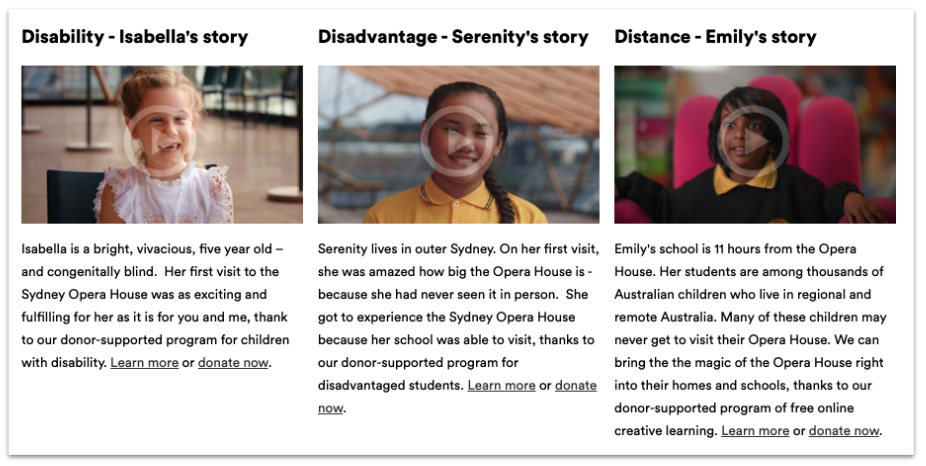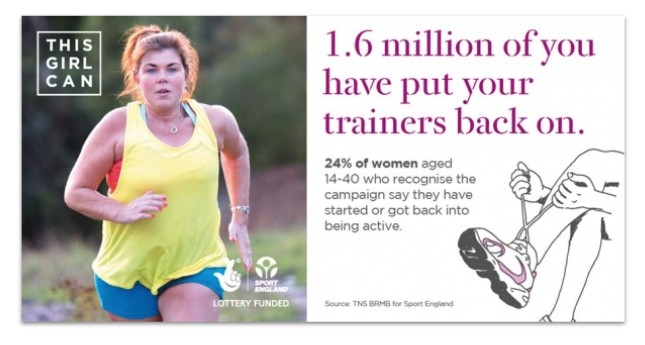Stop relying on your annual report: how to talk about your organisation's impact on your website
Arts and cultural organisations have powerful stories to tell about the work they do and the communities they impact. And the website is a prime spot for a lot of this content. Using best-in-class examples, this short article will guide you through an approach to developing impact stories that starts with the content purpose.
What do we mean by impact stories?
I’m using this phrase to mean any digital content which shows how you are delivering on your mission, vision or values. This article won’t go into how to measure or gather data about your impact. But the raw material for impact stories is usually a mix of words and rigorous datasets. We’ll dig into formats a bit later.
Why cultural organisations report on impact
To set the scene, it’s useful to revisit why cultural organisations publicly report on their impact. Broadly, I think impact stories aim to serve 3 main purposes:
- Stories that fulfill a legal or funding obligation
- Stories that build trust and credibility
- Stories that grow revenue and financial support
The primary purpose of your impact story should dictate how you go about executing the content. Let’s take a closer look.
Stories that fufill a legal or funding obligation
Most arts organisations have charitable status and/ or receive public funding that requires you to report on your activities and financial position every year - usually in the form of an annual report. The structure of these reports and the information within them is usually dictated by the public or funding body. For example, the UK Charity Commission outlines a list of requirements and specifies that the report must be submitted as a PDF.
The primary audience for this content usually has an ‘official’ relationship with you - board members, funders, the Arts Council etc. So it’s often written in a more formal tone and uses figures, spreadsheets and data summaries.
This content is typically distributed directly to these key stakeholders and the outcomes may be made publicly available through their own channels. It’s also common for arts organisations to publish these reports on their own websites as well.
But this is often where organisations fall short of creating meaningful connections with their audiences.
These annual reports are published and reused in their original state in an attempt to fulfill other aims - driving donations, building trust and credibility. And it’s not that a 50-page document can’t sometimes fulfull those aims too. But the amount of detail and heavy skew towards numbers is asking a lot from your average reader. Let's look at how we might adapt the substance of these reports to better serve other aims.
Stories that help to build trust and credibility
Telling stories about the outcomes of your work, programmes and partnerships can cement your position in the sector and build confidence in your brand. The audience for this content is broader - potential or existing customers, partners, artists, donors etc.
Most high-level donors or supporters research an organisation before giving. They want to know that they can trust where their money is going. Sure, they could read your annual report (and some of them might do). But we have to remember that online, people are goal-orientated, time-poor and often distracted. So we need to design content to meet these needs.
The National Theatre does a great job of translating content from their lengthy annual reports into alternative, digestible formats.

The ‘Key highlights’ section works because:
- it quickly summarises the most important parts of the report in a scannable format
- it focuses on the scale and reach of the impact and therefore leaves an impression
- you immediately understand what’s important to the NT, and what the focus of their strategy is
- it’s easy to read, written with an active voice, using accessible language
The RSC also challenged the annual report status quo with this interactive timeline. It’s a brilliant example of responding to a unique context (Covid) and relaying stories and data in a way that feels relevant to the time. Because of the collective lockdown experience, audiences can relate to a timeline by making connections to what was happening in their life at the time.
There are other digestible formats that work for this kind of summary content too. The Almeida Theatre produced a short video showcasing their achievements from 2022. As well as being distributed on social channels, the video also sits on their ‘Who we are’ page as a way of evidencing how they are delivering on their vision to ‘launch the next generation of British artists onto the world stage’.
The highlights video works because:
- it’s a short, coherent summary - so doesn’t demand too much of the audience
- the messaging is simple, succinct and memorable
- it uses external testimonies - quotes, reviews, award nominations - to build credibility
- it captures the scale and breadth of activity
- it hints at a call-to-action to support the organisation
Stories that are intended to grow revenue and support
With depleting public funds to the arts, impact stories can serve a specific function in helping to drive donations and financial support. The audience for this content have passed the awareness stage of the marketing funnel, they know you and trust you - potential members, donors, partners etc.
With a more engaged and invested audience, you’ve got greater choice in terms of format - both long and short-form content can work well. Unlike the broader stories that aim to build trust and credibility, these stories are successful when they are more focussed, honing in on personal narratives.
The Sydney Opera House’s ‘Give’ page is an effective example of this, with three stories that aim to build a distinctly emotional connection with the audience.

These stories work because:
- they are told from the perspective of the recipient, using their own words and voice rather than anything institutional
- this perspective allows the viewer to visualise or even experience the impact third-hand
- the slower pace of the films gives time and space to each unique narrative
- they are centred around the human experience and elicit a range of strong emotions
- there are multiple ways in to the content - the summary theme (disability, disadvantage, distance), the written case study and the film
- there is a clear call-to-action across multiple touchpoints
Website placement, framing and formats
The website is only one of many channels where your impact content might be distributed. Where the content sits on the website comes down to the primary content purpose, how the content is framed and the relevance of the content in the user journey.
Establish the foundations. The ‘About’ and ‘Support’ sections of your website are good places to start. But keep in mind that content with dates attached to it can quickly feel obsolete. (We’ve written about the importance of caring for your content once published).
Can you go beyond the basics? There are plenty of opportunities to sprinkle impact stories at relevant touchpoints throughout your site. For example, an Access page might include a fact about the number of accessible performances in the last year. Or an Education page might include a short quote or testimony from a participant.
Remember, impact stories don’t always need to be lengthy or over-engineered. Though be mindful that numbers alone often feel meaningless or fail to connect emotionally. Look to the charity sector for inspiration (impact stories are the bread and butter of their communications). This example from This Girl Can shows how framing a statistic through an everyday act instantly brings the number and story to life.

Consider repurposing content through your blog at relevant times. Opera North uses a landmark anniversary to revisit some video assets that also live in their ‘Education’ section, reframing them with a specific call to action to donate.
Summary
Impact stories are an essential part of your communication toolkit. Don’t fall into the trap of hiding them away in a PDF. Use the data that you have often painstakingly collected and distilled to work harder for you and help tell stories in interesting and creative ways. Remember:
- Establish your content purpose and target audience
- Choose a format that meets your audience needs and expectations
- Find your unique thread and develop your story
- Publish your content across relevant user journeys
- Consider if/how you can repurpose the content across other touchpoints
And that’s it! If you’d like to hear more about anything we’ve talked about here just get in touch, we’re always happy to have a chat.